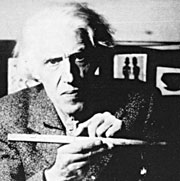
He was born on July 28, 1874, in Montevideo, Uruguay. His mother was Uruguayan and his father a Catalonian devoted to commerce. In 1891 the family settled in Mataró, Spain, his father’s home town. Torres García began there his painting studies under Joseph Vinardell. Years later he established in Barcelona where he attended the Academia Nacional de Bellas Artes and the Academia Baixas.
His connections in Cercle Artistic Saint Lluc enabled him to work as an illustrator for Catholic magazines and to take part in that group’s exhibitions. Between 1904 and 1905 he worked with Antonio Gaudí in the stained glasses of the cathedral of Palma de Mallorca and of the Sacred Family temple in Barcelona. He became interested about the work of the Italian primitive artists and about Hellenistic art. Since 1908 he realized large canvasses for the San Agustín church in Barcelona, the apse of the Divina Pastora in Sarrià and the soffits of Barcelona’s Town Hall, works which faced diverse outcomes, sometimes arising vehement disagreements when they did not meet the taste of the costumers.
In 1909 Torres García married Manolita Piña de Rubiés. He went to Paris, where he appreciated the murals performed by Puvis de Chavannes at the Panthéon. Then he set off to Brussels to decorate the roof of the Uruguayan pavilion at the Universal Exposition of 1910.
He visited Rome and Florence to study frescos, a knowledge he would use in his layouts for the Salón Saint Jordi at the Palau de la Generalitat, which, again, would trigger an impassioned polemics. A work he sent to the Barcelona International Exposition in 1911 motivated the critics, particularly Eugenio D’ors, to relate him with the noucentisme. About that time his children Olimpia, Augusto and Yfigenia were born and Torres García began to create his first wooden toys. In 1917 he carried out vibrationist compositions that he exposed together with his friend and countryman Rafael Barradas at the Galería Dalmau. That year he also published his ideas supporting modern art in the manifesto Art-Evolució.
In 1920 he went to Paris, Brussels and, finally, to New York, city in which he lived for two years unsuccessfully trying to get orders or to sell toys. Then he decided to return to Europe. Two years after being established in Italy, his son Horacio was born. In 1925 Torres García exhibited in Paris, where he had settled. The contact with the Parisian avant-garde caused him to incorporate certain Cubist aspects. However, after attending a pre-Columbian art exhibition, his first Constructive paintings cropped up.
In 1930, together with Michel Seuphor, he founded Cercle et Carré, a group in which also took part Piet Mondrian, Hans Arp, Luigi Russolo and Pere Daura. While the group dissolved after performing their first exhibition, they succeeded editing three issues of a magazine under the group’s name, in which Torres García published some twenty articles on his new ideas. His theoretical reflections, intimately related with his plastic proposals, had begun with his early work Notes sobre art (Notes about art, 1913), followed by Dialegs (Dialogs, 1915) and El descubrimiento de sí mismo (The Discovery of Oneself, 1917).
In 1934, after being absent for 43 years, he established in Montevideo, where he worked on the creation of a visual language departing from synthesis, geometric structure and the recovery of symbols from Latin-American cultures. This “new art”, based upon order and measures, aimed to become the source for social and cultural unity of the people. A regard on the role of art in preterit cultures and the fostering of collective work sought to promote the reinsertion of artistic practices in everyday life.
Torres García developed an intense educational work, lecturing, bringing up artists and publishing numerous articles. In 1935 he created the Asociación Arte Constructivo, a group that issued ten numbers of Círculo y Cuadrado (Circle and Square) magazine, inspired in its homonymous French publication. Among the plentiful theoretical production of this period clearly stand out his authobiography Historia de mi vida (Story of my life, 1934), Estructura (1935) and Universalismo constructivo. Contribución a la unificación del arte y la cultura de América (Constructive Universalism. A Contribution to the Unification of America’s Art and Culture, 1944), book in whichhis aesthetical ideology is summarized. Among his most important works performed in Montevideo is Monumento cósmico constructivo (Constructive Cosmic Monument, 1938), placed at Parque Rodó. In 1944, together with the members of the Torres García workshop, he performed a series of murals at the Hospital Saint Bois, now destroyed. His workshop, created that same year as a place for teaching and collective work, made known his ideas through the newspaper Removedor, published until 1958.
An untiring worker, Joaquín Torres García died in Montevideo, on July the 8th, 1949.